Japan #2 – Geisha – December 2014
Whatever images might come up when we think of Japan, Toyotas, Nikon cameras, Sony TVs and Sushi, the beautiful and mysterious Geishas should be included. When Monika said she wanted to go to Japan to see the Snow Monkeys, I immediately imagined going to spa and having a nice massage by a Geisha. Well, that idea was quickly blown out of the water.
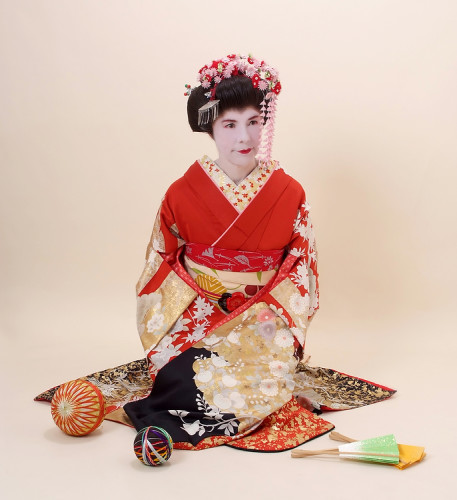 The misconception of the Geisha image comes from the period of the Allied Occupation of Japan when “Geisha girls” were Japanese women who worked as prostitutes (not entertainers). They almost exclusively serviced American GIs stationed in the country who referred to them as “Geesha girls”, a mispronunciation. These women dressed in kimonos and imitated the look of a real Geisha. Many Americans unfamiliar with the Japanese culture could not tell the difference between legitimate geishas and these costumed performers. Shortly after their arrival in 1945, some occupying American GIs are said to have congregated in Ginza, a district of Cjuo in central Tokyo and shouted, “We want geesha girls! “We want geesha girls! Eventually, the term “geisha girl” became a general word for any female Japanese prostitute. This is largely responsible for the continuing misconception in the West that all geishas are engaged in prostitution.
The misconception of the Geisha image comes from the period of the Allied Occupation of Japan when “Geisha girls” were Japanese women who worked as prostitutes (not entertainers). They almost exclusively serviced American GIs stationed in the country who referred to them as “Geesha girls”, a mispronunciation. These women dressed in kimonos and imitated the look of a real Geisha. Many Americans unfamiliar with the Japanese culture could not tell the difference between legitimate geishas and these costumed performers. Shortly after their arrival in 1945, some occupying American GIs are said to have congregated in Ginza, a district of Cjuo in central Tokyo and shouted, “We want geesha girls! “We want geesha girls! Eventually, the term “geisha girl” became a general word for any female Japanese prostitute. This is largely responsible for the continuing misconception in the West that all geishas are engaged in prostitution.
A Geika (Geisha) is a highly respected traditional Japanese female entertainer
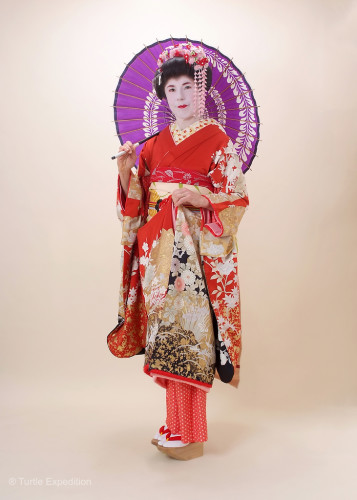 In fact, a Geisha (the correct name is actually “Geika”) is a highly respected traditional Japanese female entertainer who acts as a hostess and whose skills include performing various Japanese arts such as classical music, the traditional tea ceremony, dance, games and conversation, mainly to entertain male customers. She doesn’t do massages nor anything like it. A Geisha may gracefully flirt with her (often infatuated) guests but she will always remain in control of the hospitality. Over her years of apprenticeship as a Maiko she learns to adapt to different situations and personalities, mastering the art of the hostess. Modern Geishas still live in traditional okiya (Geisha houses) in areas called hanamachi or “flower towns”, particularly during their apprenticeship.
In fact, a Geisha (the correct name is actually “Geika”) is a highly respected traditional Japanese female entertainer who acts as a hostess and whose skills include performing various Japanese arts such as classical music, the traditional tea ceremony, dance, games and conversation, mainly to entertain male customers. She doesn’t do massages nor anything like it. A Geisha may gracefully flirt with her (often infatuated) guests but she will always remain in control of the hospitality. Over her years of apprenticeship as a Maiko she learns to adapt to different situations and personalities, mastering the art of the hostess. Modern Geishas still live in traditional okiya (Geisha houses) in areas called hanamachi or “flower towns”, particularly during their apprenticeship.
Years in training to master the art of a perfect Hostess
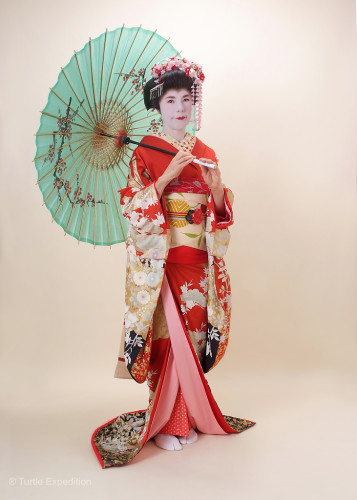
Presenting my personal Geisha (Monika). I thought about renting her out, but she couldn’t sing nor play cards in Japanese.
The Geishas’ dress, makeup and hairstyle are very complicated and highly stylized, and change as a Geisha moves through the stages of training, starting at a very early age. Simply applying the classic Geisha makeup can take over an hour before the multilayered kimonos are put on.
During festivities wearing Kimonos is popular in Japan
On the street, especially during festivals times like New Year, many young women either buy or rent beautiful kimonos and parade with their friends around the popular social centers but we actually saw women of all ages wearing kimonos on the Emperor’s birthday and at the beautiful Minazmiza theater’s Kabuki performance we attended Christmas Eve.
Monika decides to become a Geisha
To take the image to a personal level, Monika decided to become a Geisha, well, sort of. Of course, I had to become a Samurai too, well, sort of. They forgot to give me the sword. The professional makeover and outfitting took over an hour and the results were quite surprising. In the end, I seriously thought of renting Monika out but she couldn’t sing nor play cards in Japanese. Oh well. I was still hoping for a massage. That never happened either. We ate Sushi instead.
- The beautiful professional geishas are highly respected traditional Japanese female entertainers who act as hostesses.
- Their skills include performing various Japanese arts such as classical music, the traditional tea ceremony, dance, games and conversation.
- An important part of the geisha makeup is the accentuated pattern on the back of the neck thought to be the most sensuous part of her body.
- Various hairstyles and decorations change as a geisha continues her training and grows to maturity.
- The slightest detail can have important meanings as to her status.
- The complicated application of makeup takes over an hour and begins with a white rice powder paste carefully applied with a bamboo brush starting from the neck and working upwards.
- The white makeup covers the face, neck and chest.
- The ladies made an exception for Gary to be in the make-up room.
- Red color is applied to ward off bad spirits.
- Two or three un-whitened areas are left on the nape of the neck to accentuate this traditionally erotic area.
- The Obi is a sash for the traditional Japanese dress and part of kimono outfits. It is tied in a special knot used by married women known as the “taiko musubi” or “drum knot”.
- Presenting my personal Geisha (Monika). I thought about renting her out, but she couldn’t sing nor play cards in Japanese.
- Monika is wearing a traditional wedding kimono.
- Monika’s transformation was quite astonishing.
- It’s hard to get a Geisha to smile.
- Crack enough jokes and she will break into a grin.
- I always wanted to be a Samurai but they forgot to give me the sword.
- Here we are, a Samurai and a Geisha.
- Our Geisha crew: make-up artist, interpreter and photographer..
- The beautiful silk used for the kimonos is often hand painted.
- Monika tries her hand on a silk pattern creation, an art that can take years of training to perfect.
- Two young girls in their beautiful kimonos stroll through a park in Kyoto.



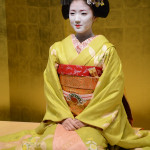
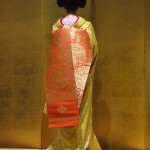
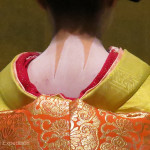
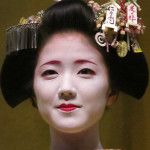
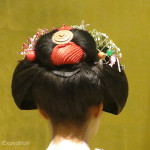
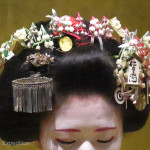
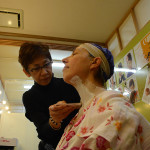
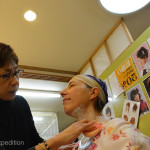
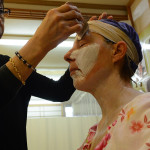
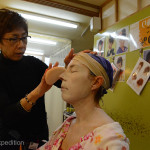
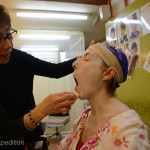
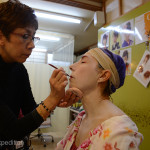
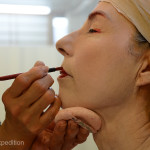
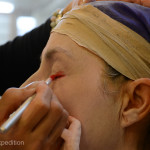
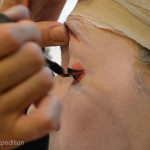
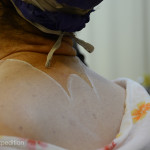
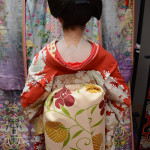
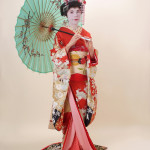
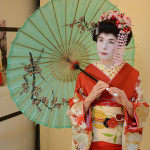
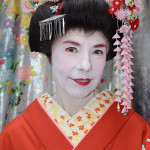
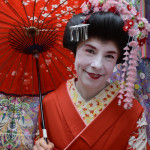
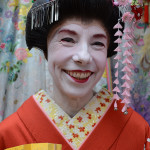
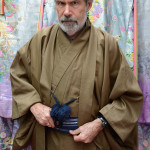
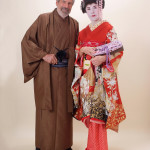
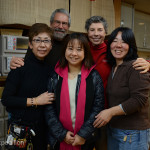
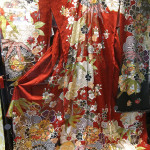
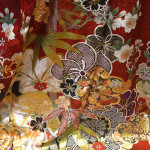
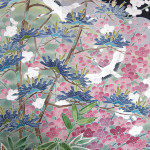
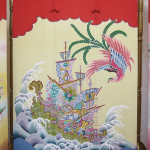
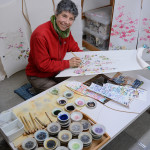
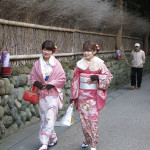





What a hoot!! enjoyed this post tremendously 🙂
Thanks Terri!